Author : Barry Tyler
AIR OF INDIVIDUALITY
Clipper Motor Yacht CEO Darren Berry must surely have had the grandiose spectacle of the Spanish City of Cordoba in mind when he commissioned the latest addition to his Cordova Series within his Clipper Motor Yacht range, for the Clipper Cordova 52 very much has a charm and air of individuality about it that is sure to capture the imagination and attention of romantic cruising folk near and far.
Clipper Motor Yachts (CMY) has been around for many years in Australia and the Pacific region in general, competing against the best the world has to offer in the niche world of trawler-style passagemaking vessels. A great Australian marine industry success story, the company enjoys a most zealous and loyal following from a large band of past and present owners throughout our region. A 100% Australian-owned company, initially their Clippers were built in Taiwan, then latterly the job of contract-building the hulls was re-located to China – for the cost savings as well as the level of quality emanating now from the top Chinese yards!
As we all know, a genuine passagemaker is often worlds apart from its weekend or extended-stay counterpart and as such Darren Berry got the best possible ‘leg-up’ for his latest Cordova range by engaging the services of top Canadian designer Trevor Bolt – arguably one of the top designers of both sail and power trawler-style and passage making vessels in the world today.
By their very nature most passagemaker designs adhere to certain layout parameters and constrictions within their designs, so it is no coincidence therefore that many bear more than a passing resemblance to each other as regards exterior ‘lines’. But don’t be fooled for as was re-confirmed after boarding the Cordova, the interiors are where it counts, where the differences lie.
Some are better than others, both in the levels of presentation and of specification. Some address long-term living requirements well, and some have that definite ‘wow’ factor. And some, like the Cordova, offer a package that combines everything – value, practicality, innovation, specification, efficiency, comfort, presentation and ambience – all in the one unique package.
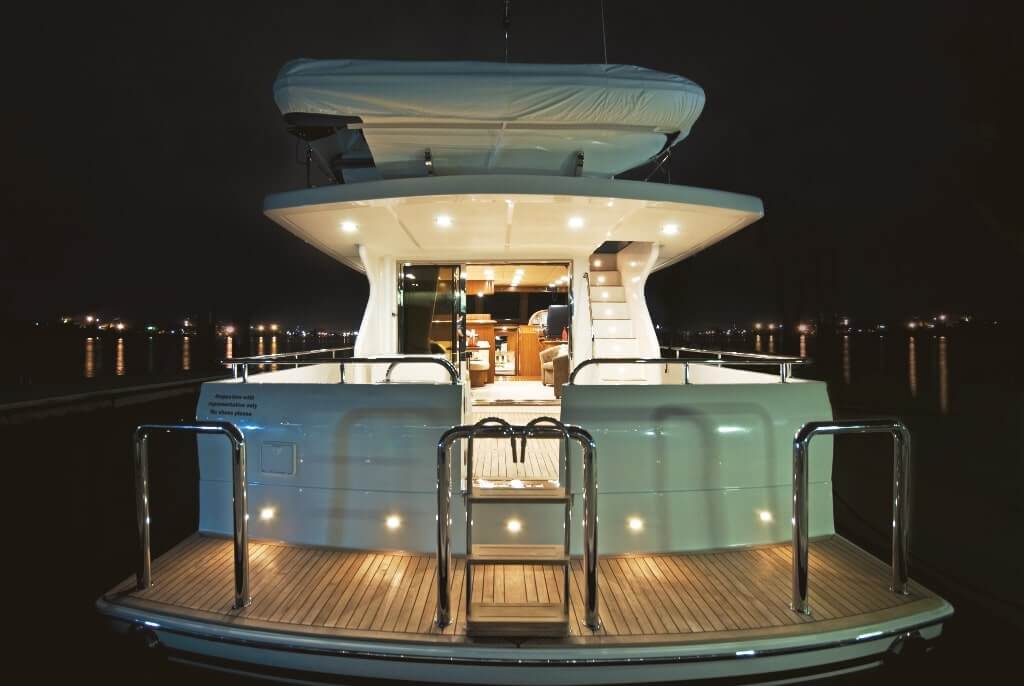
Gone the Extra Yard
It was quite obvious to me even after just a cursory glance around the cockpit area that CMY had gone that extra yard when it came to effort. Effort not only in the presentation of the stainless steel cleats and hawse holes, the sturdy safety rails and the vent covers in the floor cast with the letter ‘C’ prominent, but also with the generous amount of teak in the cockpit and the full length of the walkways each side.
The teak work around the lazaretto hatches, these walkways and indeed up the moulded stairs to the flybridge level was just superb, as was the standard of gelcoat finish. The attention to detail in general was quite staggering, very labour-intensive, and the coup de grâce was surely the sliding concatenated saloon doors and flybridge entry hatch that were finger-touch 15-jewel movements. The best I have seen – period!
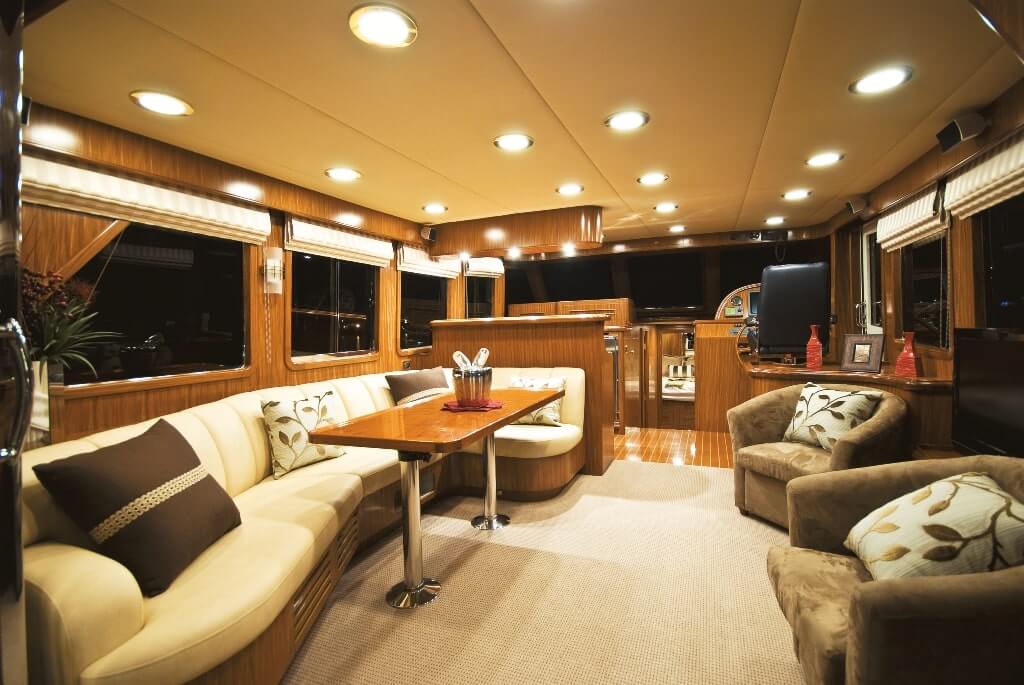
Then came the news that features such as these were all standard. “CMY has made a concerted effort to present a boat that is a genuine turn-key option,” Sales Manager Andy Diehm explained. “We have listened to our customers over the years and we believe we now offer a boat the way it should be. There is nothing more annoying for a client than thinking they are getting a boat for this amount, then when all the discretionary gear is added the price has risen dramatically.
“With this ‘52’ model the main ‘optional extras’ are the tender, the flybridge clears, the ADC davit and the genset which was upgraded from 12kVA to 17.5kVA. To that you may feel inclined to add an outdoor setting for the cockpit, the crockery and cutlery packages, maybe an engine upgrade to the 480 (or larger) Cummins engines, or indeed you may deem a watermaker a necessity.
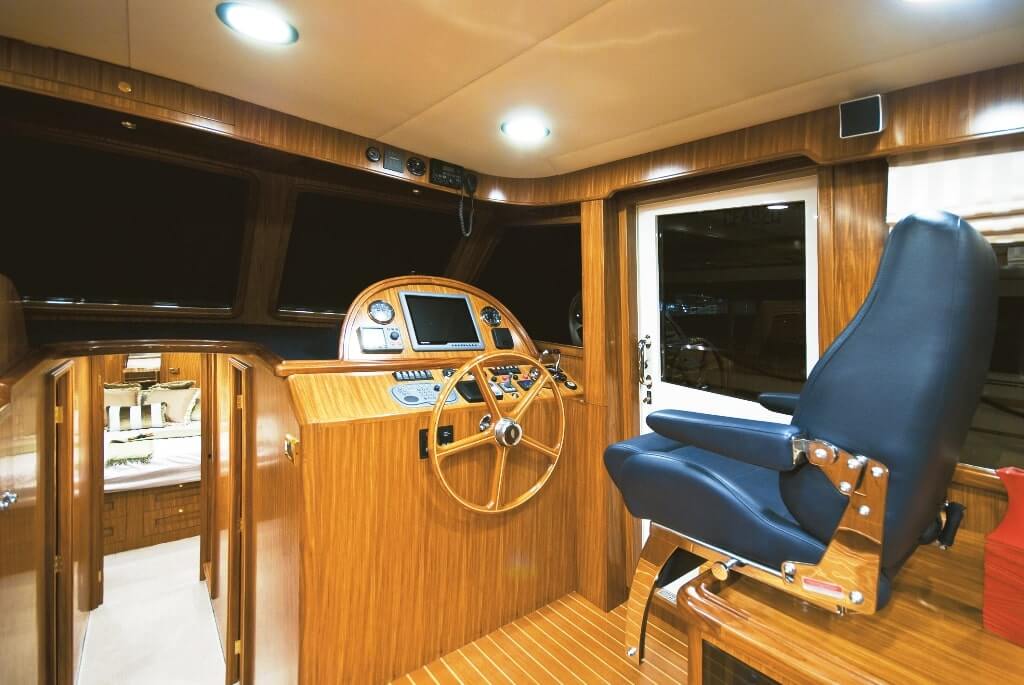
“Otherwise items such as the Isotherm refrigeration, electric oil change pump, the teak, the wash-down facilities, the integral swim platform and rails, the bow thruster, the chain counter for the Muir windlass, the electronics package, the auto pilot, the television and entertainment systems, the galley specification, the linen, the flybridge bar facilities, all lines and fenders, even the safety gear – all are standard issue!” Diehm enthused.
Space Abounds – Easy Living!
Another definite pre-requisite on any passagemaker style of vessel is space provision – how the living space is allocated. Again, Clipper has been most articulate in providing appropriate space where it is most required; typical examples were the high-use cockpit, flybridge and saloon areas. The flybridge level, accessed up a well-presented moulded staircase, was a light, bright and very spacious area for upwards of 10 people. Yet, you still had room for the tender, which was mounted on the aft end of the overhang adjacent to the davit.
Durable was the ideal descriptive for this outdoor high-use area of the boat, for the floor area was teak look-alike carpet, the seat bases, targa arch, hardtop and helm were all of a gelcoat finish and the actual seat pads were vinyl-covered rather than the leather of the lower level.
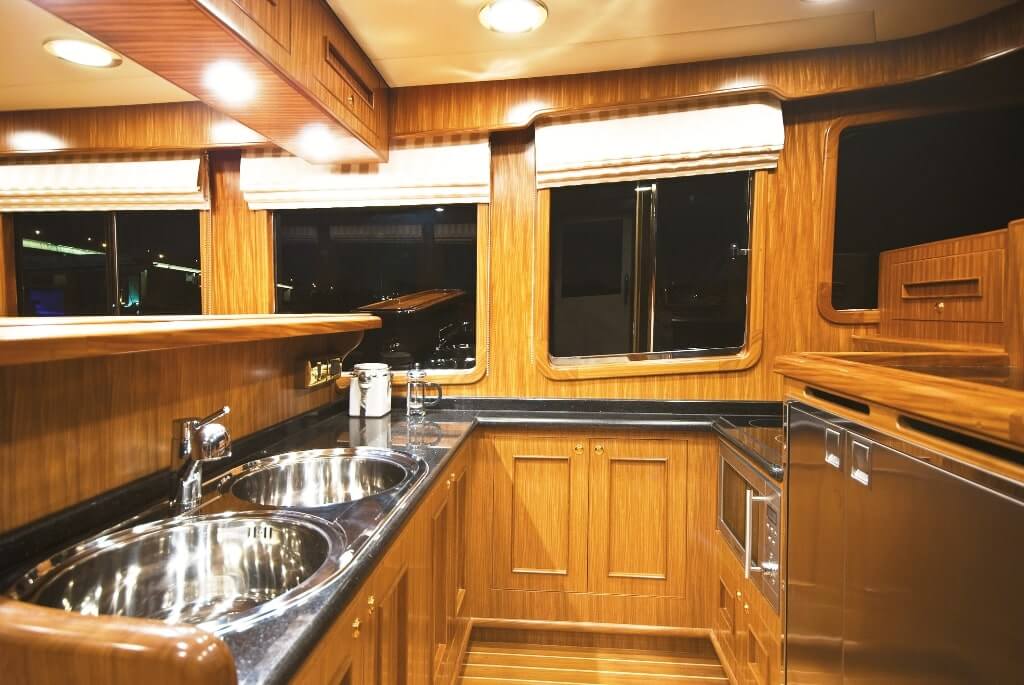
The luxury touches here were provided by the (single) skipper’s Navigator chair in front of a duplicated helm station that included the E120 Raymarine electronics package with incidentally the new G-Series screens, Hynautic steering, ZF electronic remotes and Cummins VDO instrumentation.
This was a deadly serious and well appointed helm feature, with ‘tools’ included such as the SidePower thruster controls, ICOM VHF, Volvo QL trim tabs and the Raymarine ST8001 autopilot. For entertainment purposes the bar module on the port side had a sink and running water, an electric BBQ, a storage locker and of course, refrigerator and icemaker.
The cockpit was a step up from the impressive boarding platform and presented in teak, was ready and waiting for an outdoor setting of the owner’s choice. Nicely encapsulated by the bulwarks, transom coaming and flybridge overhang above, this huge area would certainly be the ambient place to be on a hot summer evening. With the flybridge stairs to starboard and a subtle cockpit freezer to port, this cockpit was also deceptively uncluttered.
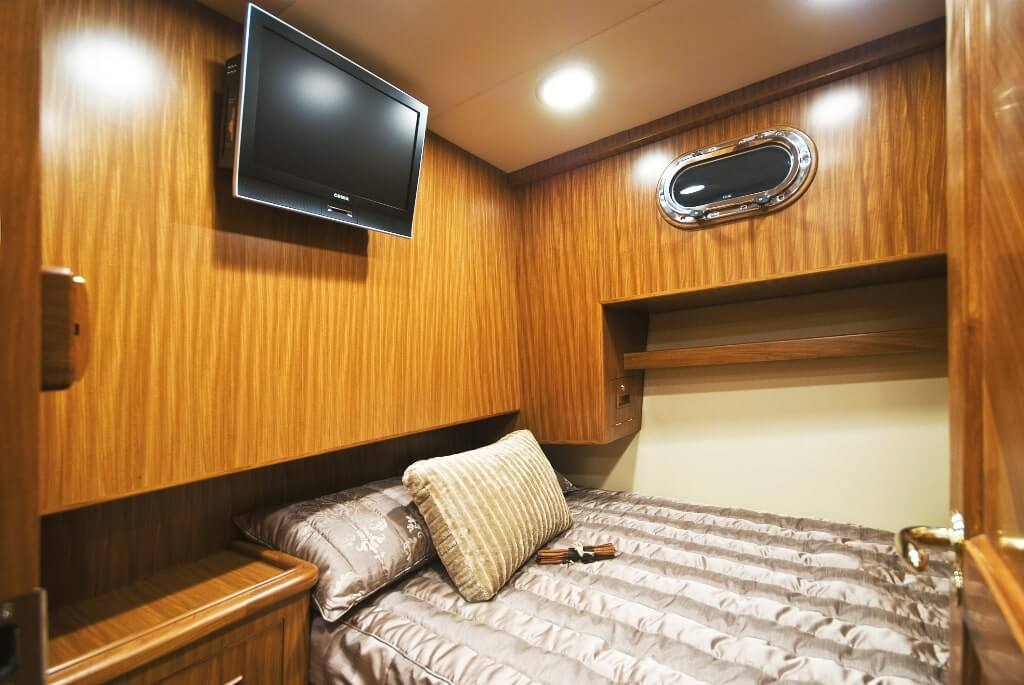
Formal Saloon
The impressive and easy sliding saloon doors, which incidentally recessed into each other to offer a two-door-width entry, led you into an again decidedly uncluttered saloon that was straight out of a superyacht. Well nearly, for it was only the relative size that made the difference. But in the context of a 52-foot boat this ‘big long room’ was surely the consummate formal entertainer – despite the fact CMY has broken with passagemaker tradition and presented the saloon and helm all on the one level – there was no pilothouse level as such.
The curved edges and shapes of the solid teak timberwork blended magnificently with the panoramic windows, the subtle dining setting, the entertainment module, the Ultraleather settees, the fabric chairs, the plushly padded side and overhead panels, and the fabric drapes – straight out of House and Garden magazine! What really took me by surprise was the copious number of lights provided – it was literally lit up like Grand Central Railway Station for from memory there were 21 large (100mm diameter) overhead lights in the saloon alone – very avant-garde!
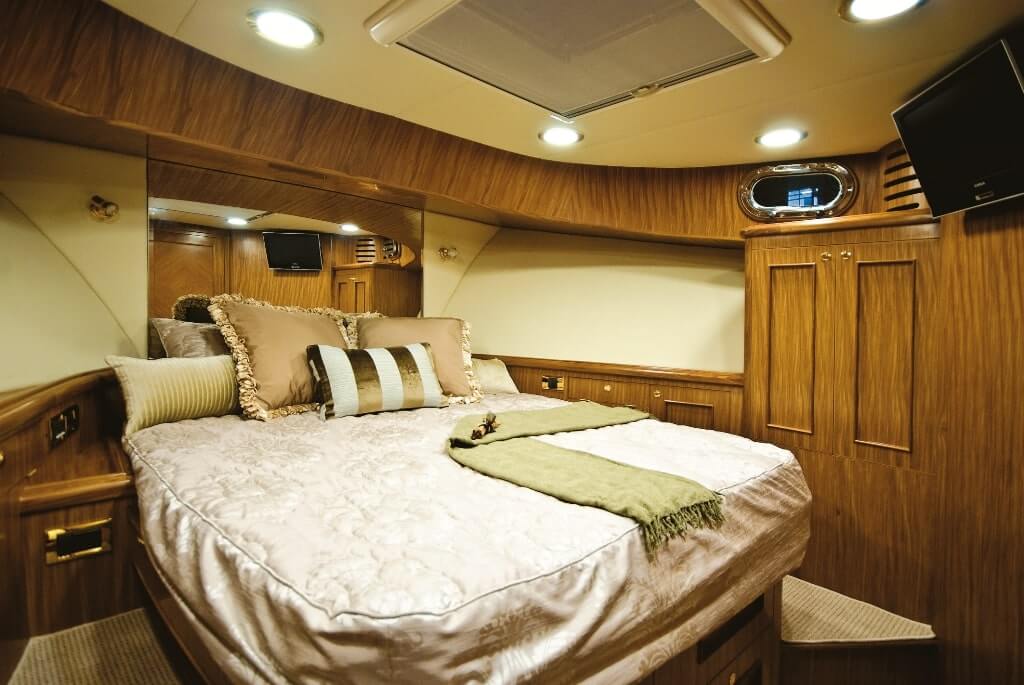
The galley to port and the entertainment module aft of the helm cleverly separated the formal and the work station areas. The galley continued the ‘opulent’ theme, for presented in the rich semi-gloss teak, it was almost too nice to use. The side-by-side Isotherm refrigerator and freezer, the Corian bench-top, the two deep sinks, the four-burner hob and the convection microwave oven all contrasted well with the teak overtones of this area.
The helm opposite was a duplication as stated, of the flybridge helm, but there were two not so subtle additions. One was the work of art that was the snug fitting teak and holly helm wheel, designed so it impinged minimally on the space allocated for access to the sliding side-entry door to the starboard walkway. The other was the Navigator helm seat that was designed in such a way (tracks recessed into the floor) that it retracted back into the seat base when not in use – to again maximise space around the side-entry door.
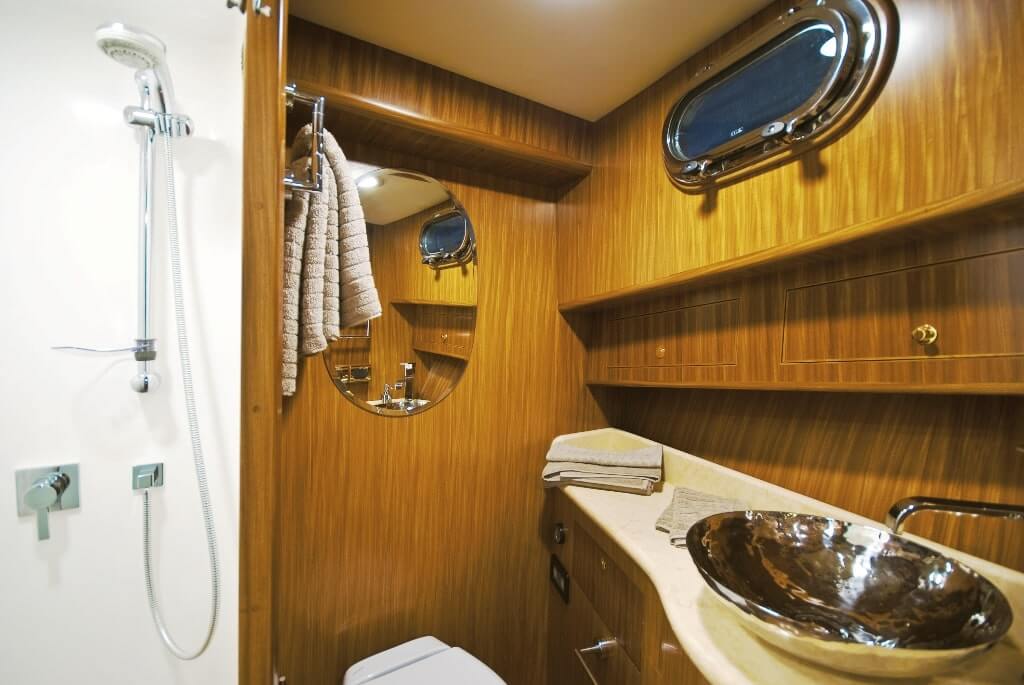
Regal Accommodation
You guessed it, the opulent theme continued unabated on the accommodation level below decks. Because the Cordova is a relatively low-profile design – the centre of gravity is deliberately kept low – this ‘52’ model is offered with just the one three-cabin, two-bathroom accommodation option downstairs and forward of the helm and galley. As such, while the master stateroom had generous space allocation around the queen-size island berth, the two guest cabins aft of this area while certainly by no means cramped, were ‘compact’ in dimension. It gets back to the old trade-off scenario, with in this case entirely appropriate space allocated to each room.
The woodwork in each of these bedrooms was yet again exemplary, magnificent in fact, as was the contemporary décor and fittings. The master stateroom offered little evidence of a bow cabin, and certainly was presented with lifestyle living in mind with its generous lashings of wood, plush panels, (heaps of) lighting, overhead and side ventilation and of course plenty of storage in hanging wardrobes, cupboards and drawers. The attached ensuite complemented the room nicely, with the sink basins especially a real revelation presented in ‘beaten’ stainless steel.
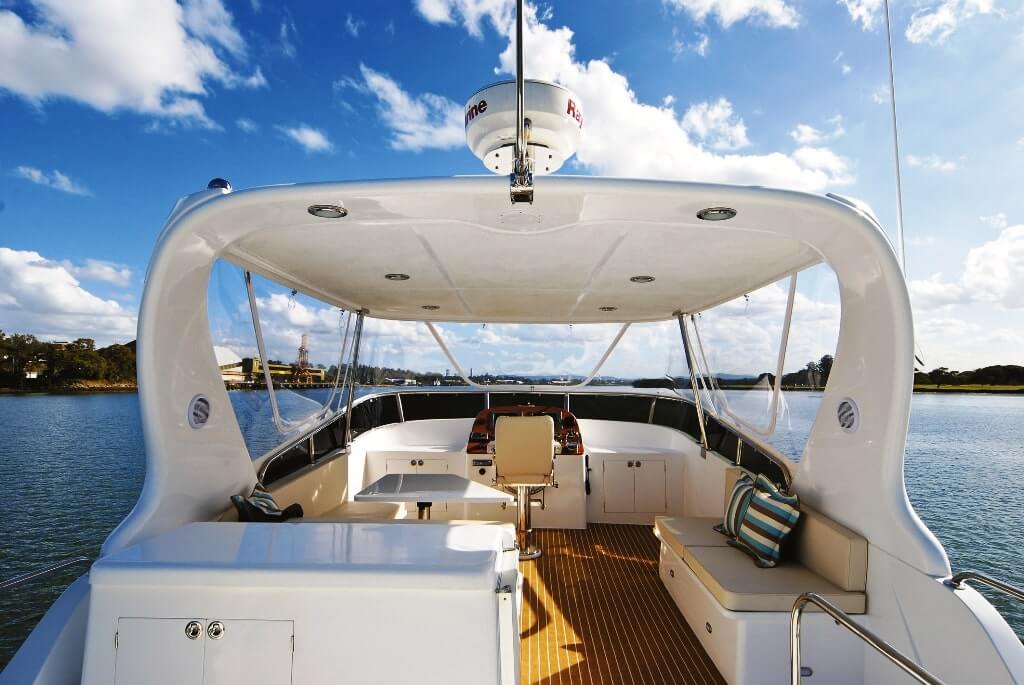
The double guest room was to port and to starboard there was a king single berth cabin. While these rooms were certainly smaller in size their efficient design and allocation of space ensured the stay was luxurious as well as entirely pleasant. Who wouldn’t be happy living in these sumptuous surroundings?
Conclusion
Definitely a passagemaker cruiser with the wow factor; the fact CMY has gone the extra yard with every facet of the vessel reflects in a most attractive and desirable end product. In every aspect the Clipper Cordova 52 was entirely passagemaker-capable; the generous provision of onboard power, the Tecma ablutions, plenty of ventilation and indeed air-conditioning, an overkill of lighting, good storage, and everything presented in a practical user-friendly manner.
Engine performance was in this instance courtesy of twin 6-cylinder 425hp Cummins diesels through ZF boxes, but if it was me I would opt for the standard specification of the 480hp alternatives. In saying that, it cruised quietly and efficiently-well at 12 knots yet when the hammers went down a top speed of 18.5 knots was available. The best part of all however was indisputably the value; AUS$1,150,000 with a plethora of traditionally ‘optional extra’ features as standard, ensured it would be a most attractive passagemaker option on anyone’s shopping list.
TECHNICAL SPECIFICATIONS
- Boat Design Name: Clipper Cordova 52
- Year Launched: 2008
- Designer: Trevor Bolt
- Interior Designer: Clipper Motor Yachts
- Builder: Clipper Motor Yachts
- LOA: 16.45m
- Beam: 4.78m
- LWL: 16m
- Draft: 1.27m
- Displacement: 20,000kg
- Max Speed: 19.2 knots
- Cruise Speed: 11-17 knots
- Construction: Hand laid solid GRP
- Fuel Cap: 2,800 litres
- Water Cap: 1,200 litres
- Engines Make: Twin 480 hp Cummins QSB
- Base Price of Boat: AU$1,100,000
- Price As Tested: AU$1,150,000




